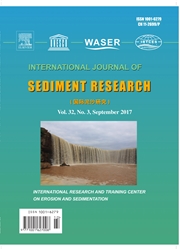

 中文摘要:
中文摘要:
穿黄和华东海(YECS ) 衣服的推迟的沉积流动地显示它的季节的可变性。一个新方法在这份报纸被介绍经由海洋颜色遥感数据,历史的推迟的沉积集中数据的统计分析,和数字模拟的检索获得流动地三维(3D ) 流动速度。沉积流动地的部件包括(i) 表面推迟的沉积集中从海洋颜色遥感数据转换了;(ii ) 推迟的沉积集中的垂直分发由历史的观察数据的统计分析获得了;并且(iii ) 3D 流动地由数字模拟当模特儿。与改进方法, 3D 在 YECS 推迟了沉积流动地被说明了。完全基于一个推迟的沉积运输模型,的数字模拟由有推迟的沉积流动的比较回答改进方法获得的推迟的沉积流动地被发现更可靠。3D 从海洋颜色遥感并且在 situ 推迟了沉积流动地观察离现实更更靠近。由分析最新获得的推迟的沉积流动地的份量上,而且,在不同区域以内的沉积侵蚀和免职的数量能被评估。在黄海和华东海之间的沉积交换能是明显的。在 YECS 的推迟的沉积运输的机制能更好被理解。特别地,推迟的沉积的长期的运输主要被发行量模式控制,这被建议,特别在冬季的水流。
 英文摘要:
英文摘要:
The suspended sediment flux field in the Yellow and East China Seas (YECS) displays its seasonal variability. A new method is introduced in this paper to obtain the flux field via retrieval of ocean color remote sensing data, statistical analysis of historical suspended sediment concentration data, and numerical simulation of three-dimensional (3D) flow velocity. The components of the sediment flux field include (i) surface suspended sediment concentration inverted from ocean color remote sensing data; (ii) vertical distribution of suspended sediment concentration obtained by statistical analysis of historical observation data; and (iii) 3D flow field modeled by a numerical simulation. With the improved method, the 3D suspended sediment flux field in the YECS has been illustrated. By comparison with the suspended sediment flux field solely based on the numerical simulation of a suspended sediment transport model, the suspended sediment flux field obtained by the improved method is found to be more reliable. The 3D suspended sediment flux field from ocean colour remote sensing and in situ observation are more closer to the reality. Furthermore, by quantitatively analyzing the newly obtained suspended sediment flux field, the quantity of sediment erosion and deposition within the different regions can be evaluated. The sediment exchange betw.een the Yellow Sea and the East China Sea can be evident. The mechanism of suspended sediment transport in the YECS can be better understood. In particular, it is suggested that the long-term transport of suspended sediment is controlled mainly by the circulation pattern, especially the current in winter.
 同期刊论文项目
同期刊论文项目
 同项目期刊论文
同项目期刊论文
 期刊信息
期刊信息
